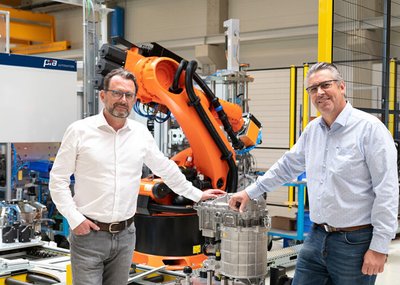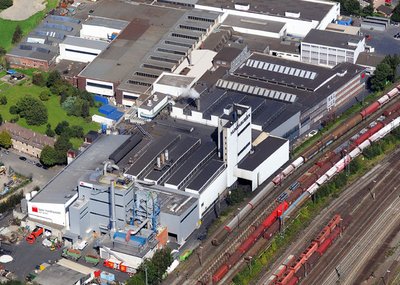- CO2 emissions of the Green Power delivery from GMH via Heine+Beisswenger to Sandvik were calculated and compared to the emissions of 2019.
- A CO2 saving of 52% was achieved in relation to the material used to manufacture the final product. When considering the production of the Sandvik Coromant adapter, there is an overall CO2 saving of 73%.
- Further decarbonization measures will follow by 2024 based on the findings of the project.
Heine + Beisswenger, GMH Gruppe and Sandvik Coromant founded the first Green Steel Partnership in December 2021. This is the first time that a cooperation of medium-sized companies in the German steel industry has been established to reduce CO2 emissions along the supply chain. The test delivery of a Green Steel product from GMH, the processing and logistics from H+B, and the further processing at Sandvik to the final product - all steps in the supply chain were optimized in terms of their CO2 emissions and compared with the reference year of 2019. The aim was to calculate concrete values for the final product, the Sandvik Coromant Adapter, and to make transparent the effects of the implemented measures on the product carbon footprint.
At the location in Georgsmarienhütte, quality and engineering steel have already been produced from 100% scrap since 1994, generating 80% less CO2 than in the crude steel production with traditional integrated steel mills with a blast furnace route. For Green Steel production, 100% green electricity was used, which again significantly reduced the carbon footprint of the product. The material was delivered to H+B by truck with a CO2-reduced LNG propulsion system. In the further outlook, additional CO2 savings will be possible in the future with the use of green hydrogen and biogenic coal.
At H+B, the measures in the area of processing and logistics were evaluated. Conversion to electric forklifts and LED lighting, use of a Daimler Actros with electric propulsion for test deliveries, automation and digitalization projects, and installation of the photovoltaic system that ensures the power supply at the site in Fellbach - the effects were proven by on-site measurements.
The energy and material efficiency projects as part of Sandvik's Green Factory initiatives have resulted in more efficient use of material for manufacturing and optimized production processes that produce less CO2. Other measures such as the conversion of electricity contracts, efficiency measures in electricity consumption, automation, etc. have contributed to additional positive effects on the CO2 balance.
The calculation of the CO2 balance sheet was based on the Green House Gas Protocol (GHG Protocol) guideline and was accompanied by external and internal sustainability officers.
Looking at the production of the Sandvik Coromant Adapter product, there is an overall CO2 saving of 73%. In terms of the material used to manufacture the end product Sandvik Coromant Adapter, a saving of approximately 52% or 1,425 kg/ton of steel used could be achieved in 2021 compared to 2019. With the batch size of 110 tons, it accounts for approximately 157 tons less CO2 produced.
This is roughly equivalent to the average annual CO2 consumption of 13 people in Germany, or about 60 Frankfurt-New York flights, or the annual average of CO2 emissions of 1,020 mid-size cars.
Based on the impressive results, the partners have also agreed to generate further CO2 savings in the business relationships by 2024. This is intended to set tangible and sustainable emphasis for decarbonization in industrial value chain in steel production and processing sectors through to the customer.
GMH Gruppe
The GMH Gruppe is one of Europe's leading suppliers of steel bars and crude steel made from quality and engineering steels. At its site in Georgsmarienhütte, the group operates one of the most modern steel mills in Europe and, together with its processing companies, is one of the technology leaders in its sector. Steel from Georgsmarienhütte is used wherever loads are the greatest, where power is generated or transmitted, and where safe and wear-resistant operation is essential. The main customers are primarily in the automotive industry and its suppliers in the forging, spring and rolling bearings industries. Other important customers are in mechanical engineering and the chain, tube and screw industries.
Heine + Beisswenger Group
Heine + Beisswenger Stiftung + Co. KG has been one of the largest family-run integrated trading and production companies within the steel and metal sector in Germany since 1901. In addition to its headquarters in Fellbach near Stuttgart, the Group operates in Dieburg, Langenzenn, Elsendorf, Trossingen and Pforzheim and has two production sites in Hermaringen and Adelmannsfelden. The range of materials comprises over 25,000 articles in the rod segment (long products) in various materials, profiles, and dimensions. The materials traded are mainly free-cutting steel, bright steel, unalloyed steel, engineering steel, stainless steel, rolled steel, tool steel, HSQ steel (machining steel), brass, aluminum and copper. In addition to the machining industry, the main sales markets are automotive suppliers and manufacturers, as well in mechanical engineering and many other steel processing producers.
Sandvik Coromant
Sandvik Coromant is part of the global Sandvik Group and the world market leader for tools and machining solutions. With its know-how, the Swedish company sets industry standards and drives innovations that are important for the metalworking industry. Advanced training, significant investment in research and development, and strong customer partnerships ensure the development of machining technologies that are changing and leading the future of manufacturing. Sandvik Coromant has more than 1,700 patents worldwide, employs more than 7,700 people and is represented in 150 countries.
Source: www.gmh-gruppe.de









